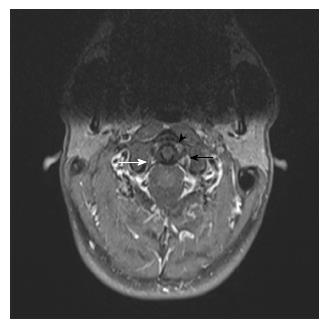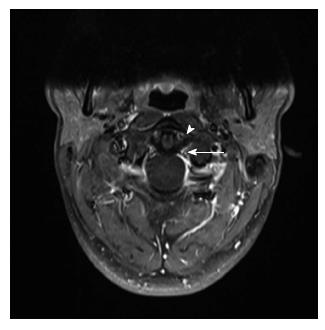Copyright
©The Author(s) 2015.
World J Radiol. Oct 28, 2015; 7(10): 357-360
Published online Oct 28, 2015. doi: 10.4329/wjr.v7.i10.357
Published online Oct 28, 2015. doi: 10.4329/wjr.v7.i10.357
Figure 1 Multidetector-computed tomography coronary construction.
Verification of a relationship of dens axis, atlas and occipital condyles. Asymmetry of the dento-axial joint space between left and right (white arrows) with widening on the left side. No micro- or macro-fracture.
Figure 2 High resolution contrast-enhanced 3T magnetic resonance imaging, fat-saturated gradient echo sequence performed 6 mo following the trauma.
In the contrast-enhanced T1w fat-suppressed magnetic resonance imaging sequence note the contrast enhancement in the periligamentous venous plexus (arrow head). On the left side lower than on the right side. No TS symmetry of the joint space left vs right side (black and white arrow).
Figure 3 Follow-up magnetic resonance imaging.
High resolution contrast-enhanced 3T magnetic resonance imaging, fat-saturated gradient echo sequence. After physical therapy stabilization. Note the clear contrast enhancement in the periligamentous venous plexus (arrow head) and the symmetric space evaluation (white arrow).
- Citation: Kaufmann RA, Marzi I, Vogl TJ. Delayed diagnosis of isolated alar ligament rupture: A case report. World J Radiol 2015; 7(10): 357-360
- URL: https://www.wjgnet.com/1949-8470/full/v7/i10/357.htm
- DOI: https://dx.doi.org/10.4329/wjr.v7.i10.357















